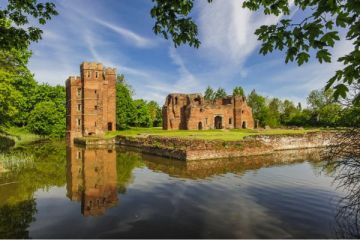
When William the Conqueror defeated King Harold at the Battle of Hastings in 1066 he faced the challenge of how to control his new realm and subdue the native population. One of the ways he went about exerting his control was to built castles in important urban areas and strategic places. These castles were initially little more than high earth mounds surmounted by a timber palisade, and a larger palisade enclosing a 'bailey', or courtyard.
History
One of this first wave of Norman castles was erected at Leicester, on a high castle mound overlooking the River Soar. The bailey at the foot of the castle mound was defended by a deep ditch, or moat, reaching as much as 10 feet wide and at least 5 feet deep. The ditch was spanned by a timber bridge.
Within the bailey were a number of secondary timber buildings, and also the church of St Mary de Castro.
In the 12th century, the castle defences were gradually rebuilt in stone. Around AD 1150 Robert le Bossu, Earl of Leicester, began building a great hall. The Earl's wealth came in part from his control of vast royal forests, and he used this access to a ready supply of oak timber to build a large and sumptuous hall in keeping with his status. Leicester Castle became a showpiece, an opulent residence befitting the House of Lancaster.

The great hall is probably the oldest aisled and bayed timber hall in England. The medieval core of the hall is now hidden behind an elegant 19th-century facade, but underneath that facade is a medieval timber building, with traces of original windows still visible in the south wall.
The castle acted not just as a residence but as the administrative centre of the Honor of Leicester, the Earls collection of estates. Parliament met three times in the great hall; in 1349, 1414, and 1425/26. The Earl held court in the hall, and finds of human remains in the castle mound suggest that criminals were executed atop the mound on the Earl's gallows.
Edward I stayed here in 1300, and his son Edward II visited in 1310 and again in 1311. Edward III followed suit, visiting with his court for a lavish hunting party in 1390. The last record of royal residence comes from 1483, when Richard III wrote a letter 'from my castle of Leicester'. The unfortunate king probably stayed at the castle again in 1485 just before his defeat at the Battle of Bosworth.
Beside the great hall, a large stone kitchen was erected. The vaulted cellar of this building still survives and is known as John of Gaunt's Cellar, though the stonework suggests that it could be as old as the great hall itself. John of Gaunt's cellar was rebuilt in 1400 when the present ceiling was added. Graffiti etched into the cellar walls shows that it was used as a prison during the Napoleonic Wars.

From the 15th century, the castle acted primarily as a setting for the Courts of Assize, and for special functions like balls. In 1821 the great hall was remodelled as two separate courtrooms, with a civil court on one side and a criminal court on the other. A cell block was later added, and a Grand Jury room built on the upper floor.
The top of the castle mound was flattened in 1840 to make a public bowling green. It is now an open space with benches for relaxing, with good views over the city and the riverside.
In 1888 the crown sold the castle to the county justices, and court continued to sit in the castle until 1992. Perhaps the most famous case to be tried at the castle was the 'Green Bicycle Murder' of 1919, when Ronald Light was controversially acquitted on a charge of murdering Bella Wright.
In 1926 the area surrounding the castle great hall was cleared and planted to create Castle Gardens, a public park. You can still see traces of the castle's foundation walls and drains in Castle Gardens.
The Great Hall is only open on certain Sunday afternoons from February through November, but the castle mound is open daily. You can access the mound from Castle Gardens. You can also view the exterior of the great hall, with access from The Newarke and Castle View.

About Leicester Castle
Address: Castle Yard,
Leicester,
Leicestershire,
England, LE1 5WH
Attraction Type: Castle
Location: The castle mound is accessed from Castle Gardens, but the castle great hall can only be accessed from The Newarke via Castle View or from Castle Street and Castle Gate, beside St Mary de Castro church.
Website: Leicester Castle
Location
map
OS: SK582041
Photo Credit: David Ross and Britain Express
HERITAGE
 We've 'tagged' this attraction information to help you find related historic attractions and learn more about major time periods mentioned.
We've 'tagged' this attraction information to help you find related historic attractions and learn more about major time periods mentioned.
Find other attractions tagged with:
NEARBY HISTORIC ATTRACTIONS
Heritage Rated from 1- 5 (low to exceptional) on historic interest
Prince Rupert Gateway (Turret Gateway) - 0 miles (Historic Building) ![]()
Leicester, St Mary de Castro Church - 0 miles (Historic Church) ![]()
Newarke Houses Museum - 0.1 miles (Museum) ![]()
De Montfort University Heritage Centre - 0.1 miles (Museum) ![]()
The Magazine - 0.1 miles (Historic Building) ![]()
Leicester, Bow Bridge - 0.2 miles (Historic Building) ![]()
Wygston's House - 0.2 miles (Historic Building) ![]()
Jewry Wall, Leicester - 0.2 miles (Roman Site) ![]()
Nearest Holiday Cottages to Leicester Castle:
East Norton, Leicestershire
Sleeps: 4
Stay from: £434 - 1418
More self catering near Leicester Castle










